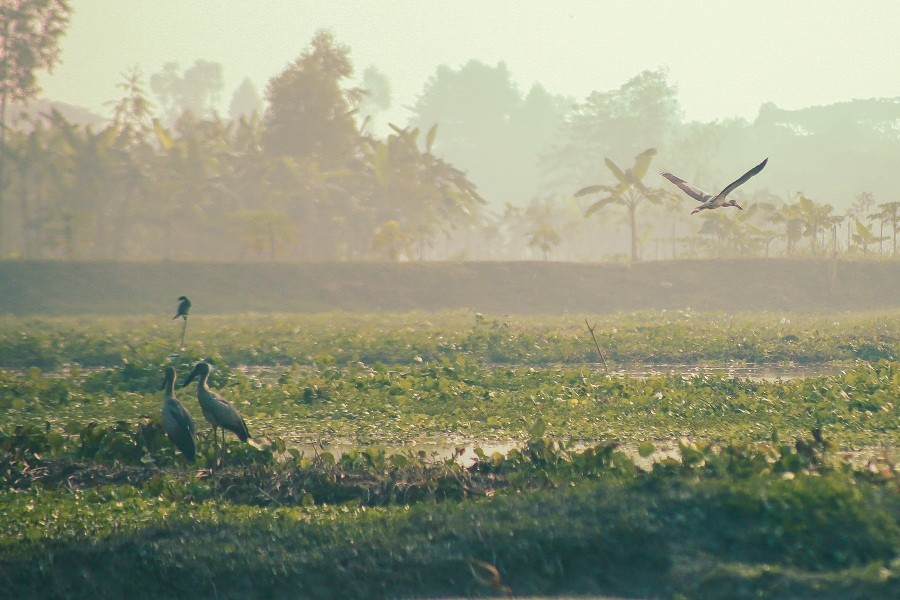The ancestral home of Satyajit Ray, Sukumar Roy and many other notable figures, Kishoreganj, a small district of the larger Dhaka Division, has a significant influence in the socio-political arena of the historic region of Bengal. From the picturesque greenery beside Nikli Hoar to the ancient ruins of Isha Khan's palace, the district has a lot more to offer.
After a rough week full of exams and academic pressure, the writer went to Kishoreganj with his friends from the Department of Economics, University of Dhaka. Despite being sceptical about the tour at the beginning, the experience was enough to break the shackles of monotony and boredom from their lives.
Photo - Salman Siddique
We started the journey early in the morning by train on September 22nd. As there were five of us, we booked an entire air-conditioned berth, and to say the journey was enjoyable is an understatement.
The view from the window was breathtaking, and it is certainly one of Bangladesh's most scenic travel routes. We lost count of how many cups of coffee we ordered in the meantime, as Bangladesh Railway has top-notch coffee, and it went well with the overall ambience.
The train journey was surprisingly short, and it didn't come to our mind that the distance between the capital and Kishoreganj was not that much. After we arrived, we went to the ancestral home of one of our friends, Salman Siddique Prottoy, which is not far away from Sholakia Eid Maidan, the largest in Bangladesh.
After taking two hours of rest, we walked around that place. Sholakia Maidan seemed to be a large, desolate field at that time. It seemed hard to imagine the field that would host hundreds of thousands of people for the largest Eid Jamat in Bangladesh.

Photo - Salman Siddique
It was still afternoon, and after snacking at the local places where the food was surprisingly cheap and fulfilling at the same time, we went out to visit the Chandraboti Temple. It is an ancient temple in the town of Kishoreganj known for its unique architecture and is associated with the first female writer of Bangla literature.
The temple complex was beautiful, and the surrounding villages looked like the ones in our collective stereotype of Bangladeshi villages - green, quaint, and serene. However, the temple built in the 16th century reminded us of a forgotten time and age when the socio-cultural landscape of Bengal was completely different from what it is now.
Since it was already 9 pm, which is quite late by the village standards, we moved back, and in the meantime, we had our supper from the Taj Hotel in Kishoreganj with beef bhuna and rice. The meal will remain stuck in our taste buds for a long time.
The next day began even earlier, as we planned to sail through the Nikli Haor the entire day. We started our journey at 9 in the morning. We already had a boat reserved, so we didn't have to go through the hassle of looking for a boat, which seemed to bother many people. We continued on the boat with some dry food, as we planned to stay on the boat for quite a long time.
The sky was a bit gloomy, so we didn't have to endure the scorching heat of the sun, something that many people warned us about. Nevertheless, the scenes from the boat were breathtaking and out of this world, as we witnessed villages on the banks that looked straight out of movies directed by Hayao Miyazaki's Studio Ghibli.

Photo - Salman Siddique
We were also lucky enough to see the acrobatic Ganges River Dolphin, which, as we were told, was not a common sight in the Haor areas. We also saw lots of different kinds of birds, with herons being the most prominent.
As the sun gradually started to show its wrath, we didn't stay in the boat longer and reached for the banks. There we tasted a variety of street foods, with a pickle made of Chalta in a specific way entertaining our taste buds the most.
We returned to Dhaka the next day, on September 24th, as we couldn't stay away long from our everyday chores.
While returning by the train, a strange melancholy gripped us as this short but memorable trip to a relatively obscure district of Bangladesh took our minds from the problems of day-to-day life.


